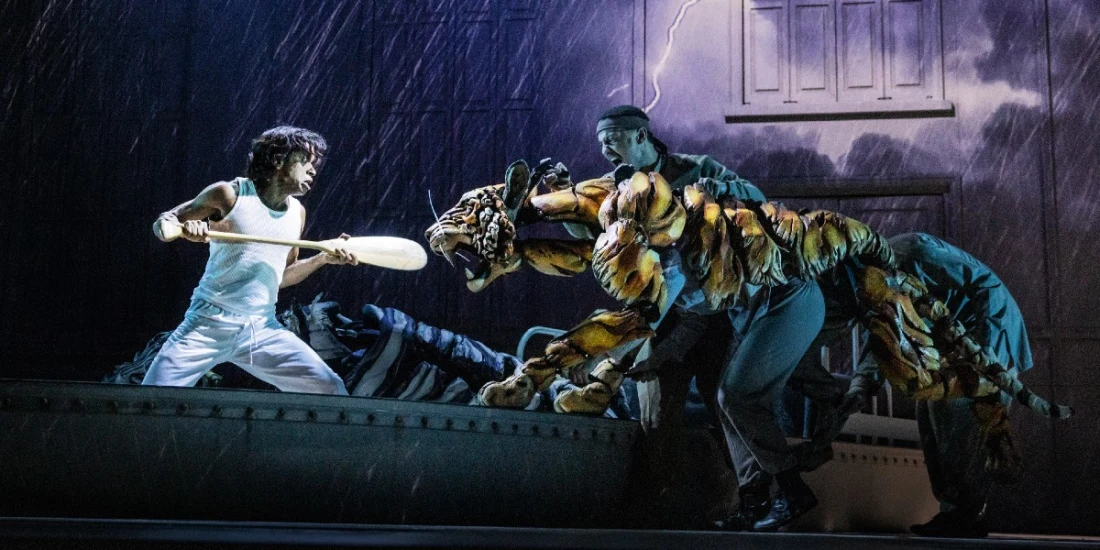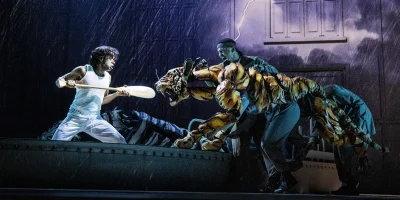
How the 'Life of Pi' Broadway puppets make animals come alive
Learn fun facts about the puppets featured in this show adapted from Yann Martel's bestselling book, which won awards in London for its inventive stagecraft.
Puppetry is for more than just kids' shows. The Lion King proved that on Broadway in 1997, bringing African animals to life with groundbreaking (and Tony Award-winning) designs. In 2012, War Horse galloped onto Broadway with life-size horse puppets that won their designers various awards. Now, in 2023, animal puppetry takes center stage again for Life of Pi.
Adapted from Yann Martel's bestselling adventure book of the same name, Life of Pi sees the title teenager fight for survival following a shipwreck. His only companions on a tiny lifeboat in the ocean are a zebra, orangutan, hyena, and Bengal tiger.
The stage adaptation comes to New York from London, where the animal puppets captivated audiences — and awards committees. The seven puppeteers who played Richard Parker, the tiger puppet, made history by jointly winning a Best Supporting Actor prize, a first at the Olivier Awards. Two of them, along with fellow Olivier winner Hiran Abeysekera as Pi, now bring their talents stateside. You might swear you somehow arrived at the zoo when you see these animals before you.
Learn more about how these actors, and puppet designers, Nick Barnes and Finn Caldwell, bring the wilderness alive on the Gerald Schoenfeld Theatre stage. Then get tickets to Life of Pi on Broadway, and prepare to be swept up in their epic journey.

The puppetry originally looked more like The Lion King's.
The Lion King's puppetry takes many different forms, from small birds on handheld poles to life-size elephant puppets with a performer in each leg. That show also incorporates masks, showcasing the actor in traditional clothing while maintaining an animal element.
Barnes and Caldwell initially designed puppets and masks to represent Life of Pi's animals, testing what would work best. Intricate puppets best captured the animals' dangerous, primal nature and most realistic movements. Making the animals feel different from the humans — and keeping the audience on the edge of their seat, wondering who could become prey — is key to the thrill of Life of Pi.
The puppets are designed to look like wreckage.
All four animal puppets are painted to look like they're made of driftwood, calling to the shipwreck they all endured. The puppets are lifelike, but not entirely naturalistic — the puppeteers are visible beneath missing bits and pieces of the animals' anatomy, similar to how a boat breaks apart during a wreck.
In addition, the Life of Pi play takes place mainly in flashbacks — Pi recounts his adventures to fellow hospital patients after being rescued. The driftwood-like puppet design points to the link between the shipwreck and the animals in Pi's memory.

The tiger puppet's anatomy resembles an actual tiger's.
Just as a real animal's bones and joints are made of different types of bodily matter, the tiger puppet is, too. The "skeleton" comprises plywood, aluminum, and nylon, and the "joints" are made from elastic bungee cords. A foam-like material called Plastazote is molded and painted to cover this framework like "skin."
The tiger puppet takes over 300 hours to make.
The London puppet took 345 hours — that's more than 14 days! Sanding down the raw materials for painting is a bulk of the job, and painting every nook and cranny also takes a substantial amount of time. Five to six people work on each puppet from start to finish — sanding, painting, sculpting each piece, and assembling them all.

The Life of Pi cast includes experienced and new puppeteers.
Some actors that come aboard Life of Pi have experience working with puppets, but others learn as they go. In London, the puppeteers had a whole week of puppetry training before actual rehearsals. This time let everyone familiarize themselves with the puppet and learn to do basic movements inside it, like running, sitting, and jumping.
By the time they get to the stage, the performers make animal movements look easy — and since they're partially inside the puppet, you might forget they're even there.
Staging the puppets is like choreographing a dance.
Suppose you've marveled at a group of dancers changing formations and artfully performing their moves without colliding. In that case, you'll be just as amazed by how the puppeteers seamlessly move as one to make the puppets run and jump in creative ways — all without leaving the lifeboat.
Most Life of Pi puppets each have multiple puppeteers operating their various limbs at once. The range of motion the puppets achieve within these confines is something to behold. They're just one element of the inventive stagecraft that makes Life of Pi such a unique play. They take on a life of their own, and they capture audiences' emotions as much as any other living actor.
Photo credit: Life of Pi on Broadway. (Photos by Matthew Murphy and Evan Zimmerman for MurphyMade)
Originally published on


